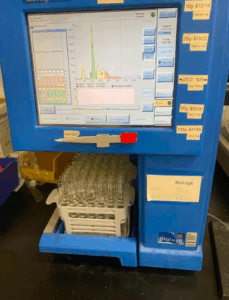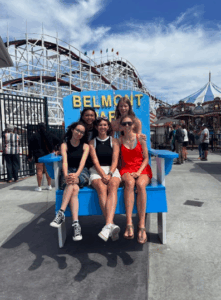Hi everyone, my name is Maiya Wagner, and I feel so blessed to be given the opportunity to work in San Diego interning at the Scripps Research Institute. I am working at the Engle lab, which works with catalysis, and is run by Keary Engle. and with Madison Wagner, a third-year graduate student and PhD candidate. There are a few other people in the lab too, a mix of PhD Students and Post-Docs, who are all so smart and kind. This week was my first week, and it was a lot of hard work. Madison is currently working with transient directing groups, or TDG’s. These guide reactions to create better results. The products we hope to achieve are UV reactive, and could potentially be used in OLED screens, bacterial imaging, or even cancer treatment.
Most of my first week was split into learning a few techniques – purification, creating starting materials for reactions, and testing them. The starting materials need to be created before being put into the reactions, but to ensure a good reaction, it also needs to be purified and then tested to make sure it’s the compound we want.
To create the starting materials, we added palladium and copper catalysts, as well as triethylamine and a few other chemicals. In general, these are Sonogashira Coupling reactions, using the palladium and copper co-catalysts to create the desired products – a compound with a triple bond between two carbons. Because the reactions would have reacted with air and the particles in the air, it’s all done under an inert nitrogen atmosphere. This mixture then gets left overnight on a magnetic stirring plate. You can test to see if it’s viable by running a TLC with three spots – the starting material compound, both of them, and the product. If no starting material is remaining, it worked. TLC stands for thin layer chromatography, a method of separating a compound based on polarity. It travels up the plate based on how polar that molecule is too. If it looks good, and glows in the right places (which changes based on the compound), then it can be purified.
Once completed, it needs to be purified. To purify a compound, it gets dissolved in acetone, and silica powder is added. Then I learned how to use a machine called a rotary evaporator, that depressurizes the mixture and allows it to be evaporated more quickly. Then the compound is essentially powder, which allows it to be scraped into a column and an automated column runs a column chromatography. Column chromatography separates compounds by its components, usually by polarity, and this purifies the compound. The automatic column also can test UV reactivity, so we were able to tell where the purified product was by noting where the peaks were (I will add a picture of the automatic column at work). To confirm that the peaks were the product we want, Madison taught me how to run a TLC. In addition, we ran NMR(nuclear magnetic resonance) tests, that shows how a molecule behaves and other factors on a graph. An NMR works similar to an MRI, using magnets, but the compound gets moved instead of the magnets and at a much smaller scale.
At the beginning of the week, I knew nothing more than what I learned in my chemistry classes at school. But now, I know slightly more! I also feel a lot more confident running these processes on my own, as throughout the week Madison allowed me to do more and more on my own as she and I felt more confident in my abilities. Slowly I’m learning to run these reactions by myself, and memorizing all of the steps. It’s been really fun and a great opportunity, and I look forward to learning more about the chemistry and running more purifications, testing, and creating more starting materials. Though I haven’t met Keary yet, the other people in the Engle lab have been so nice. This week I ran five reactions, and purified eight in total. It’s a lot of work but it’s a lot of fun and I’m learning so much. On friday, the lab gets together and has a group meeting – they start with warmups, and then have some presentations, finishing with a ‘problem set.’ It was very confusing and complicated chemistry, but the people there were kind enough to help me through and explain some of it, the warm up consisted of naming chemical structures. Then two people gave presentations updating the lab on their progress, Anne Ravn and Shenghua Yang. Afterwards, there was a problem set – essentially a brain-teaser worksheet with a few questions about different chemical structures and finding hypothetical errors. Again, the lab was very kind and afterward explained it somewhat to me, and I started to understand better than I had before. All in all, it was a very good week, and I definitely learned so much.
Outside of the internship, I’m living with four other interns – Shiloh Warthen, Lana Kenworthy, Azari Guerrero, and Reign Icasiano. We’re slowly exploring the city and learning to be more independent together. We’ve been shopping and on Saturday went to the beach with our house mom Jennie and her kids. So far it’s been a great experience in all ways and I look forward to continuing.




There are no comments published yet.